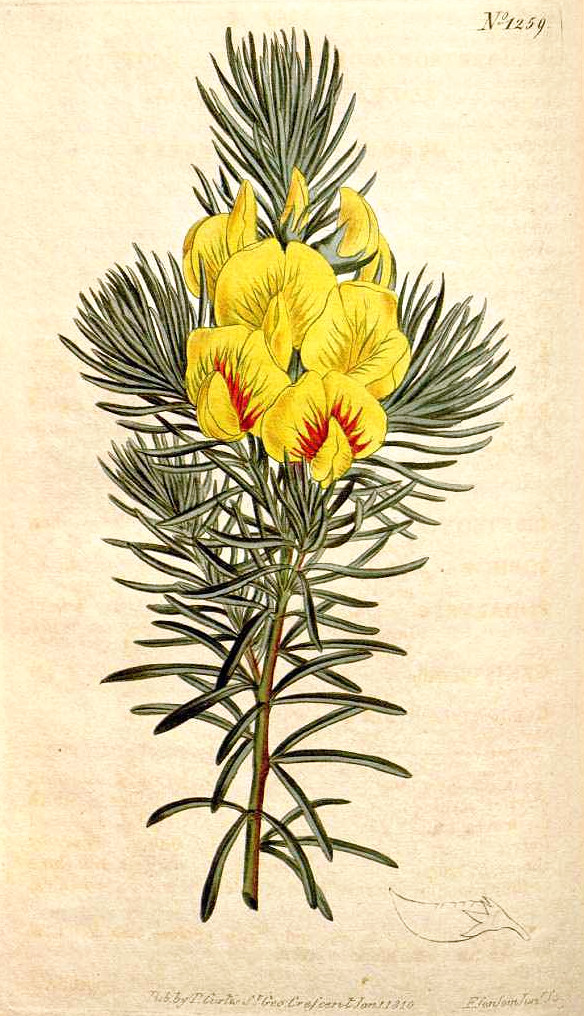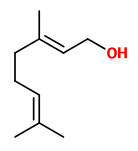Cyclopia genistoides (L.) R.Br. - Fabaceae - Common Honeybush-tea, honeybush (tea), Honigbusch
Small much-branched woody shrub, up to 1m high, native to South Africa; stems golden yellow; leaves short, needle-like, arranged in threes along the branches; flowers bright yellow, sweetly scented; small pods that turn brown with brown seeds inside.
Cyclopia genistoides (PlantZAfrica.com)
„This species is one of five types of Cyclopia used for honeybush tea. It has an extent of occurrence (EOO) of 16357 km² and an area of occupancy (AOO) of 172 km². It is known from at least 30 locations. The population is suspected to have undergone a 25% decline over the past three generations (150 years) due to the combined effects of urban expansion, agriculture, and opportunistic wild harvesting to supply the honeybush tea industry.“ Common Honeybush-tea (Red List of South African Plants)
„Plants from the genus Cyclopia are easily recognized by their sweetly, scented yellow, pea flowers. All 23 species of Cyclopia occur only in fynbos; from the Cederberg Mountains, southwards to the Cape Peninsula and eastwards to Port Elizabeth. Usually species are restricted to very small areas and then also to very specific habitats like high mountain peaks, marshy areas, shale bands and wet southern slopes.
Honeybush tea [Cyclopia genistoides (L) R.Br.] was traditionally harvested only for home use, but has recently developed into an exciting, new commercial product as the demand has increased from tea-lovers around the world. Other species such as Cyclopia intermedia (bergtee) and Cyclopia subternata (vleitee) and Cyclopia sessiliflora (Heidelbergtee) are also harvested for tea.“
Cyclopia genistoides (Plantzafrica)
The green-grassy 6-methyl-5-hepten-2-one (54% TIC) was identified as the major constituent of green honeybush aroma.
„Linalool (36%) was identified as the major constituent of fermented tea aroma, while 6-methyl-5-hepten-2-one (14%) and the terpenoids limonene (3%), trans-furanoid linalool oxide (2%), cis-furanoid linalool oxide (2%), α-terpineol (17%), nerol (3%), and geraniol (11%), most of which are known to have floral and sweet odours (Arctander, 1969), occur in significant relative quantities. The terpenoids geranyl acetone, β-cyclocitral, and dihydroactinidiolide were present in significantly lower concentrations in fermented C. genistoides than in unfermented material from the same batch.“
[Le Roux, M., et al. „Chemical characterization of the constituents of the aroma of honeybush, Cyclopia genistoides.“ South African Journal of Botany 74.1 (2008): 139-143]
More than 20 Cyclopia species of honeybush grow in the wild, but only Cyclopia intermedia, Cyclopia
subternata, and Cyclopia genistoides, are currently commercially exploited to manufacture tea. Many of the terpenoids identified in C.intermedia and C.genistoides like α-terpineol, nerol, geraniol, linalool, linalool oxides, and eugenol, are known to have floral, sweet, sweet-woody, floral-woody, or spicy odors. „Sensory descriptive analysis showed that C. subternata differs from C. genistoides with respect to their sensory profile with C. subternata predominantly having a fruity sweet and apricot jam-like flavor note as opposed to C. genistoides having a vegetative sweet aroma.“
[Roux, Maritha Le, et al. „Characterization of volatiles and aroma-active compounds in honeybush (Cyclopia subternata) by GC-MS and GC-O analysis.“ Journal of agricultural and food chemistry 60.10 (2012): 2657-2664]
„The “characteristic” sensory profile of honeybush can be described as a combination of “sweet-associated”, “floral”, “fruity”, “woody” and “plant-like” aromas with a sweet taste and a slightly astringent mouthfeel… C. sessiliflora samples were associated with “green” aroma (“plant-like” and “green grass”), as well as a sour taste, and C. genistoides with “apricot jam” aroma and a slightly bitter taste. C. intermedia did not display a distinct profile as most positive attributes were perceived at moderate intensities. Although certain compounds can be linked to specific a roma notes, it is important to realize that aroma notes of different compounds can mask or suppress one another, and combinations of aroma compounds can produce new aroma characteristics.“
[Theron, K. A., et al. „Sensory profiling of honeybush tea (Cyclopia species) and the development of a honeybush sensory wheel.“ Food research international 66 (2014): 12-22]
„Honeybush tea is mostly enjoyed as a hot beverage of the ‘fermented’ product. ‘Fermentation’ refers to the high-temperature oxidation process essential for the development of the sought-after sweet, floral aroma and flavour, and brown colour. Traditional medicinal uses include use as an expectorant in pulmonary tuberculosis, chronic catarrh, and a restorative with astringent properties. ‘Caspa Cyclopia Tea’ was the first branded product to appear on the market in the 1960s. The development of a formal industry in the 1990s gave rise to different branded honeybush products, and the production of extracts.“
[Joubert, Elizabeth, et al. „Cyclopia genistoides.“ The South African Herbal Pharmacopoeia. Academic Press, 2023. 171-197]

Cyclopia genistoides (L.) Vent.; Curtis, W., Botanical Magazine (1787-1948) vol. 31 (1810) t. 1259
http://botanicalillustrations.org/species.php?id_taxon=6624





